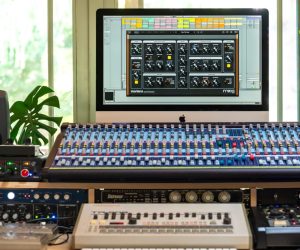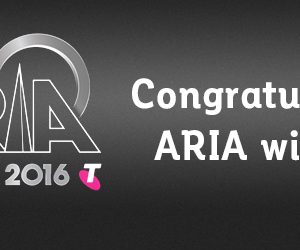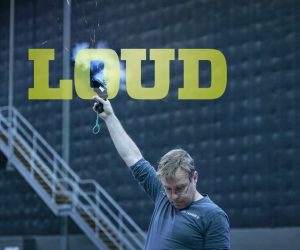
ARIA Album of the Year: Boy & Bear: Moonfire
Aussie band Boy & Bear makes good and comes out with the big gong at the ARIAs. AT delves into the record with producer Joe Chiccarelli and guitarist Killian Gavin.
Recorded at Blackbird Studios, Nashville, USA
Mixed on API Legacy Plus console
When you walk into an awards show joking that you should have brought bagels along as a symbolic gesture, you’re probably not too worried about the outcome. So when Boy & Bear walked away with five wins from seven nominations for their debut album Moonfire, it was a welcome surprise, for the band, Australia, and even a producer tucked up in bed all the way over in LA.
Not only did the band take out, bear with me here, Album of the Year (the big one), Best Group, Breakthrough Artist — Album, Best Adult Alternative Album, and Breakthrough Artist — Single (for Feeding Line), but producer, Joe Chiccarelli was also nominated for a Best Producer gong. Both the Best Engineer and Best Producer awards stayed on shore with Franc Tetaz for his work with Gotye. Which is probably for the best anyway, reckons Chiccarelli, “I was so flattered when that all came down. I didn’t expect any of that. Though not being an Australian citizen I don’t know how that works! Really, if you’re not a citizen and not part of the community, it’s kind of awkward to give it to a foreigner.”
FRONT MAN SYNDROME
For the boys in the band, it was a nice “cherry on top” of what has been a boom period for a band that started out with more front men than a boy band. Guitarist, and singer, Killian Gavin explains the Boy & Bear genesis, which also goes a long way to explaining their herculean grasp of vocal harmonies. “Dave [Hosking, actual lead man] was a solo artist. Tim [Hart] and I were both the singers of our own bands. Tim and his brother John [Hart] were in a band together, and Jake [Tarasenko] was also in another band. So there were four separate projects happening.
We all knew each other and had gigged with each other a fair few times. Eventually we just started helping Dave out because he was playing by himself.”
With only enough room for one leading man, Killian assumed the role of guitarist, and Tim took up an entirely new post as the drummer. “Tim said he’d only been playing drums for a year when they started recording, and was really hard on himself. But he was a really good drummer,” said Chiccarelli. “I would ask him to try a certain beat and he would look at me like I was a martian because it was beyond his musical vocabulary, as a drummer that is. Yet he really tried and he’d always come up with great parts. He really rose to the occasion in the studio. Based on the demos I was afraid that he might be light and not intense enough, but he really poured a lot of passion into the drums.”

DEMO-IT-IS
Boy & Bear went through multiple demo stages before heading into Blackbird Studios in Nashville. Both Killian and Tim have small ProTools rigs for recording in bedrooms and living rooms to see how the songs are taking shape. Killian’s rig has been downsized somewhat to make way for new guitar gear. But the crux of it is a 002, monitors and a Macbook Pro, with a few mics between he and Tim, including a Neumann and Audio-Technica.
To step away from the engineering side of things and get a better idea of how the songs are sounding as a band, the five of them decamped to a small Sydney studio to lay down live tracks and all the layers.
In the end, parts of those demos ended up directly influencing the finished product. “In fact, the harmonies of Part Time Believer are really straight off their demo,” said Chiccarelli. “Most of the other demos were sort of stark, but that was one of the last ones they recorded and it was relatively fully formed. The A&R guy Mike Taylor was very much in love with the demo and actually a couple of times, he had me tweak the final master version to get closer to the demo.”
Killian: “When we recorded the chorus harmonies over in Nashville it just didn’t sound the same. We couldn’t figure out what we were doing wrong that we couldn’t recreate what we had on the demo. We ended up contacting the studio back in Sydney to get them to send us the ProTools session file and importing each of the harmonies into the recording on the album, placing them over what we’d already recorded in Nashville.
“We realised we weren’t doing the same harmonies and the timbre of the voices wasn’t being recorded the same. So we asked the guys back in Sydney what microphones we’d used, and re-recorded them all in Nashville with a Shure SM7 through a really average preamp because it sounded a bit more muffled.”

THE PRICE YOU PAY
Through a set of entirely fiscal events, it ended up cheaper to fly the band over to Nashville and record at Blackbird. Chiccarelli pitched a number of local studios he was comfortable working in. The Grove Studio on the central coast of NSW, and Neil Finn’s Roundhead Studios in Auckland were on the list, but Blackbird came out trumps. Now, before you go decrying the death of the studio in Australia, and yanks invading our turf, Chiccarelli and Killian gave us the reasons why Blackbird was the final choice [To restore your faith in the Aussie studio scene, check out another American, Jonathan Burnside’s article in this issue based entirely at The Grove. It goes both ways — Ed].
“It doesn’t make any sense,” said Killian. “It was this weird coincidence where it was cheaper for us to go overseas than to record an hour north of Sydney. The dollar at the time was doing really well and also Joe could get really good rates on the studio because he’s really good friends of the owner.
Chiccarelli explains the main thrust a little more: “The one thing about Blackbird is they have a great complement of musical instruments, believe it or not they have about 20 drum kits, about 150 guitars, and about 50 guitar amps. If we had done the record, even in Los Angeles, Auckland or anywhere else for that matter, hiring instruments would have bumped the budget up substantially.”
Killian again: “It was so much more intensive than any other studio we’d looked at. And on a musician’s wage we’ve got our guitar that we’ve had since we were 15 years old — it was nice to go to a studio where they have over 100 guitars and however many pianos and amplifiers. It meant we could have a go at trying to achieve all the sounds that we’ve dreamt of trying to pull off.”
And that was the main point Chiccarelli stressed to the boys when he came on board as producer — to try new things. So while jumping in a Tarago with the same gear they’d been using since the EP may have actually been cheaper, it didn’t fit the vision for the album, which Chiccarelli describes as “more cinematic.”
SEEING THE CINEMATIC VISION
“We definitely wanted the album to sound rockier than the EP,” said Killian. “More electric guitar driven and bigger drum beats — a bit more upbeat. Joe’s ear is pretty spectacular and he could hear the gaps in the songs and what kind of instruments would sit correctly in that part of the field of sound. He also had a lot to do with helping us tune the drums and selecting what kind of kit, guitar and amp to use while discussing how it makes sense in the song.”
What Chiccarelli envisioned was more of a layered sound, fleshing out the songs and pushing the boundaries of their arrangements in a way the demos hadn’t. “we used a lot of subtle parts that build the dynamics and flesh out the chords a bit — coming up with chord voicings that are just thick enough but not too thick. If you orchestrate it in ways where one part is playing the top line and one part is filling out the middle and the other part isn’t competing too much in the middle then you can make things pretty big,” explains Chiccarelli. “And you can do the same thing in terms of notching out frequencies in guitars that compete with other guitars, or trying different guitars and different amps. I always look towards the final mix while I’m recording. I choose all the compression, EQ and effects while I’m cutting the basic track. So my rough mixes are very close to my final mixes.”
we put the microphone in the bathroom and then Jake, John, Tim and I stood just around the corner in the hallway and yelled at the top of our voices


DRIVING THE LOW GEARS
“In mixing Feeding Line, the most that I’ve done is some parallel drum compression,” said Chiccarelli. “Sometimes I use a couple of different compressors — usually a Chandler Zener compressor as well as a Neve 33609 limiter. I never use very much stereo bus compression — not more than a dB or two. From there it is just making the bottom end as big as possible because when you have a song that’s really just built around that four-on-the-floor driving beat, you’ve got to make sure that it is driving and keeps your body moving for four and a half minutes.”
The low end is driven by the kick, which Chiccarelli says, didn’t use any samples, “But we did take some time finding the right vintage Gretsch bass drum and tuning and miking it properly.” The other half of that equation was the bass, which for three-quarters of the album ended up being Jake’s Epiphone Jack Cassidy bass. “It has a particularly interesting honk to the mid-range,” said Chicarelli. “That kind of cuts through the track, and the flat-wound strings are a bit more rubbery, which really helps with the bottom end.
“We used a Telefunken v78 as a direct box on the bass, and the Ampeg B15 seemed to be warm and rich, perfect for filling out the kick sound. I often use an Ampeg SVT or sometimes a Divided By 13 bass amp. However, nothing sounds like a great Ampeg B15 from the late sixties.”
The synths went through a lot of different treatments, depending on the song, many times they were put into distortion pedals like a Hot Cake, or into an old Master Room or Sansui spring reverb, and sent to a Fender Deluxe amp, blending a mix of the direct and amp sound together. Some of the string sounds were processed with delays or long reverbs from an Eventide H3000 or space pedal, while the real string arrangements, by Patrick Warren, were recorded in LA.
VOCAL CHAIN GANG
Dave’s lead vocals were mostly recorded through a Telefunken 251 with slight UREI 1176 compression, and a fair amount of parallel compression during the mixing, including a Purple Audio MC76 Limiter. The background vocals were recorded using either a Neumann U67 or M49 through a Neve 1073 and UREI LA3A.
With all the vocal prowess packed into the band, Chiccarelli set the boys up in a smaller studio at Blackbird to manage their own harmonies while he and Killian layered up guitar parts. Chiccarelli would just pop in every now and again, listen to the parts they’d come up with and suggest less voices on a part or different singers for different textures, to avoid wallpapering every song with harmonies.
A lot of it was trial and error says Killian, not only for the parts, but the recording of them too. “For Milk and Sticks they had this bathroom at Blackbird that sounded really cool,” he said. “So we put the microphone in the bathroom and then Jake, John, Tim and I stood just around the corner in the hallway and yelled at the top of our voices. It wasn’t always a gang mentality, there was plenty of individual takes. But nothing can beat standing around the mic together, it just doesn’t have the same energy otherwise. So whenever there was something that needed a group vocal we would always get in there together and do however many takes it took for all of us to get it right.”
FEELING THE LOVE
Rekindling the love for some of the older material was a big part of the role Chiccarelli played in shaping the album. Like most artists who’ve played their old stuff too much, and reckon their new stuff is the bee’s knees, songs like Golden Jubilee, an important up-tempo lift on the album, had lost some of their appeal for the boys. So much of the deep re-arrangements also served to pique the boy’s interest in those songs they’d done before. Which shows that there’s never really any set formula for demo-ing, because while they did reference some of their demos for the album, the process almost knocked off a few of its highlights. Thankfully they persevered, because Moonfire really is a great album. Some might say album of the year.
















RESPONSES